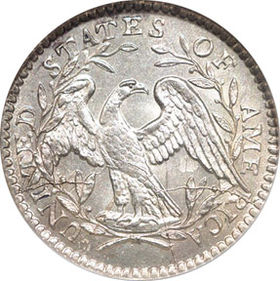Half dime
However, others consider the 1792 half disme to be nothing more than a pattern coin, or "test piece", and this matter continues to be subject to debate.
[6] The obverse of the Draped Bust half dime was based on a sketch by artist Gilbert Stuart, with the dies engraved by Robert Scot and John Eckstein.
The primary 1796 variety bears fifteen stars representing the then number of states in the union.
The reverse bears an open wreath surrounding a small eagle perched on a cloud.
The obverse remained essentially the same as the prior version, but the reverse was revised substantially.
This reverse design first appeared on gold quarter and half eagles and then dimes and dollars in the 1790s.
The design features Liberty seated on a rock and holding a shield and was first conceived in 1835 used first on the silver dollar patterns of 1836.
In 1860, the obverse stars were replaced with the inscription UNITED STATES OF AMERICA and the reverse wreath was enlarged.
The Seated Liberty half dime was produced at the Philadelphia, San Francisco and New Orleans mints in an aggregate amount of 84,828,478 coins struck for circulation.




